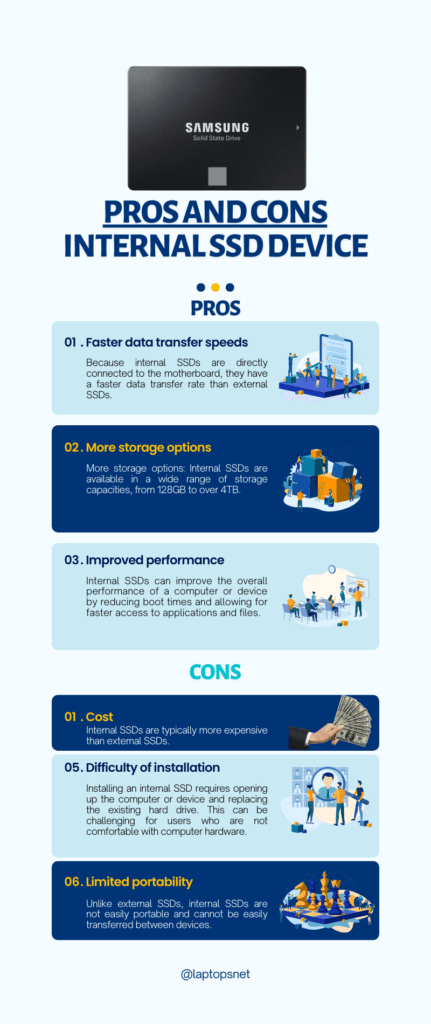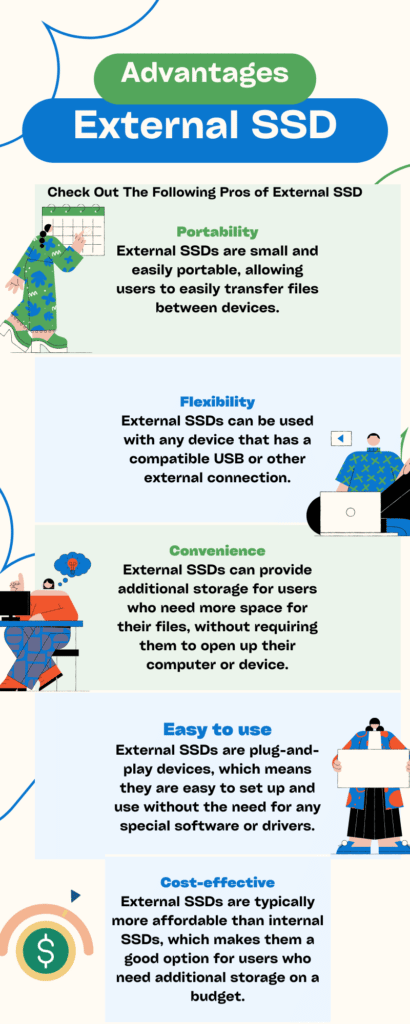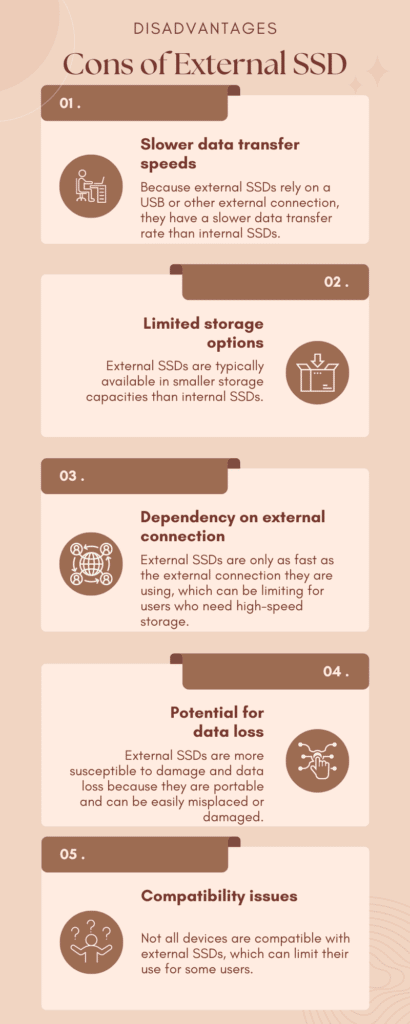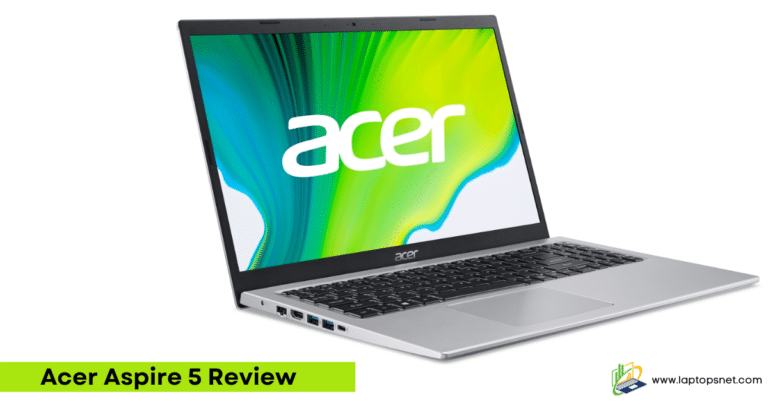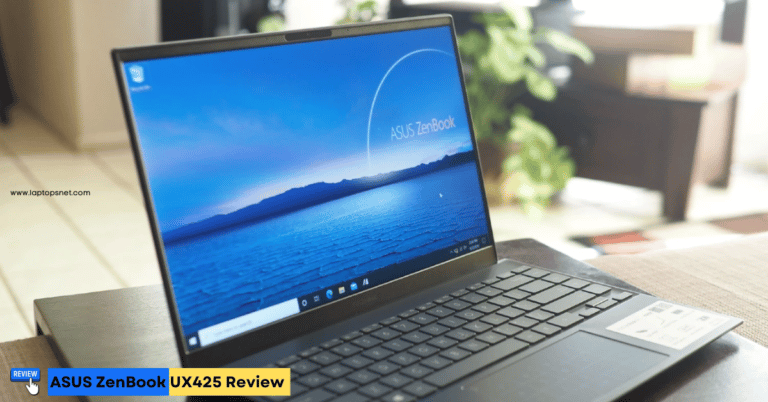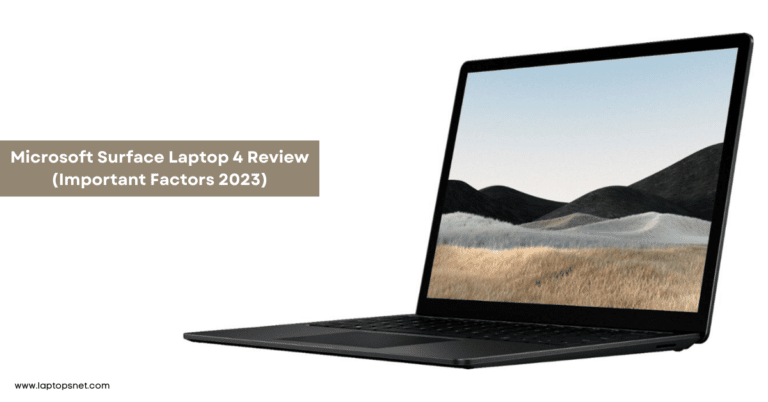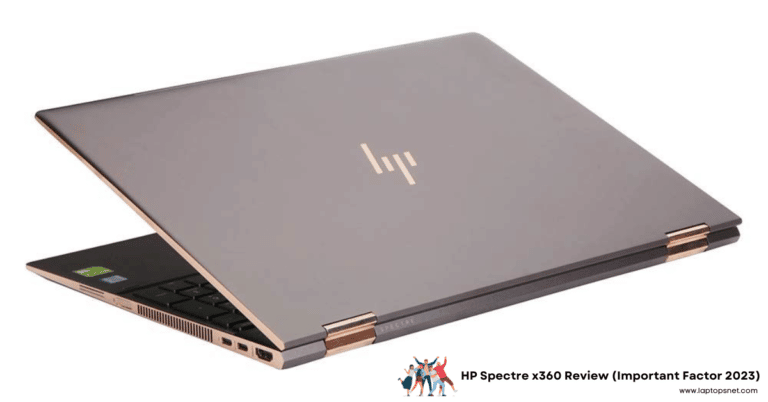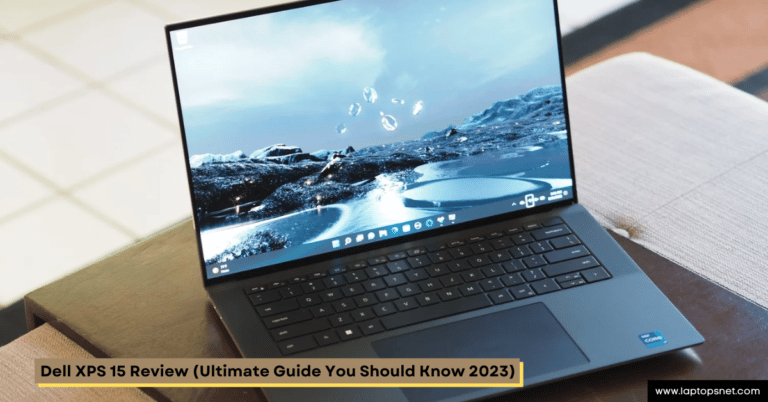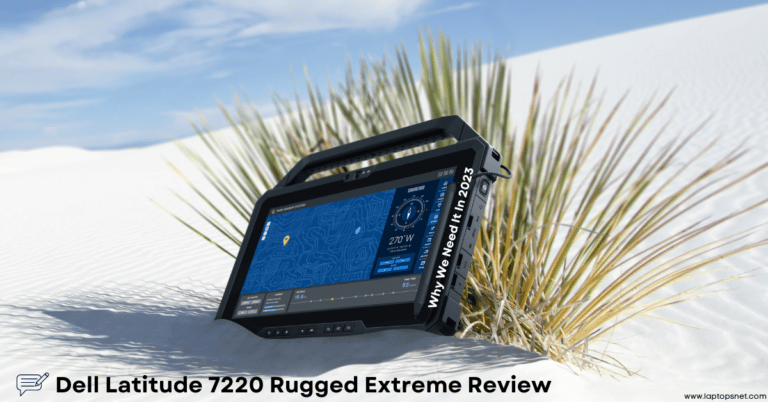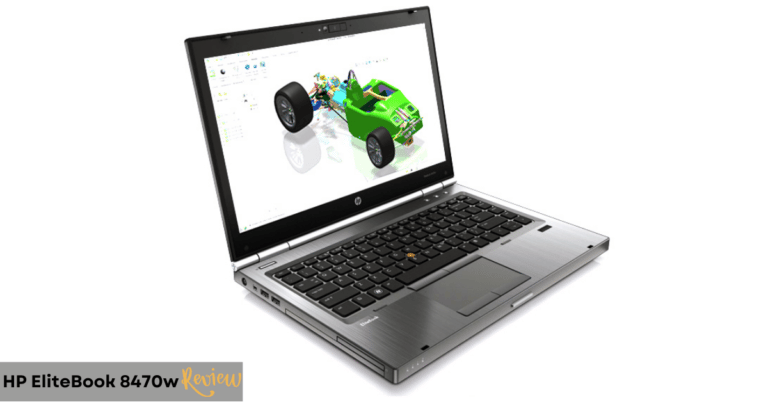As technology advances, the need for faster and more efficient storage devices has become increasingly important.
In recent years, solid-state drives (SSDs) have become popular for internal and external storage due to their high speed and durability.
But what is the difference between an internal and external SSD, and which is the best option for your needs?
In this article, we will compare internal vs external SSD and the pros and cons of each option to help you make an informed decision.
Internal vs External SSD 2023
It is difficult to say which is faster without more information. In general, internal SSDs tend to be faster than external SSDs because they are connected directly to the motherboard and can take advantage of the faster data transfer speeds of the internal bus.
External SSDs, on the other hand, is connected via a slower interface like USB, which can limit their speed.
However, the specific speeds of any given SSD will depend on several factors, such as the type and speed of the interface, the quality and speed of the components used, and the design and firmware of the drive itself.
To determine the relative speeds of two specific SSDs, it would be best to consult reviews or benchmarks of those specific drives.
Details about External SSD and Internal SSD

An external SSD is a storage device that connects to a computer or other device using a USB or other external connection. It is a portable, compact option for storing and accessing data.
On the other hand, an internal SSD is a type of storage device installed inside a computer or other device. It is directly connected to the motherboard and does not require a separate connection.
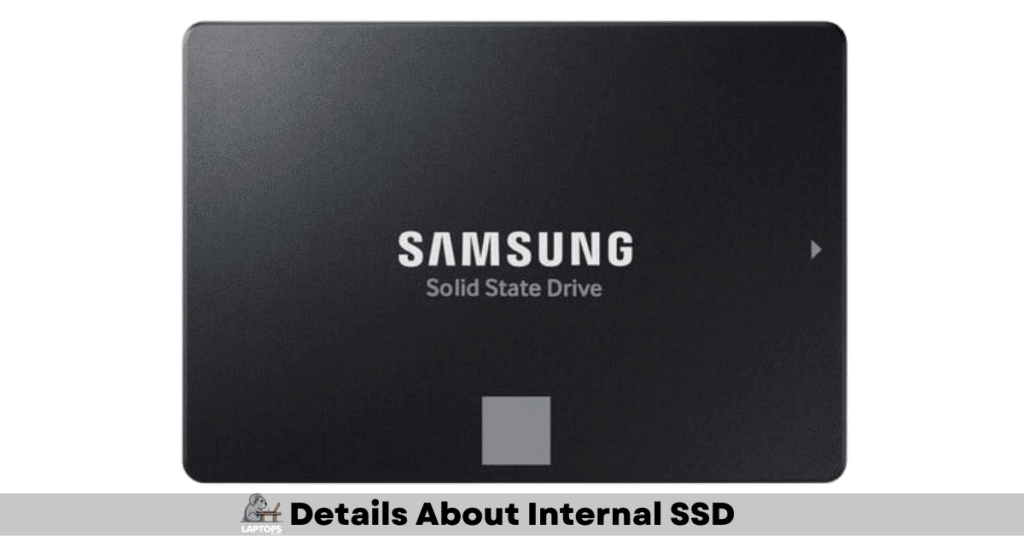
Both types of SSDs use the same technology, but internal SSDs are generally faster and more efficient due to their direct connection to the motherboard.
External SSDs are more convenient for users who can access their data on multiple devices or need a portable storage solution.
Portable SSD Vs Internal SSD
The main difference between a portable SSD and an internal SSD is that a portable SSD is designed to be easily carried and connected to different devices, whereas an internal SSD is installed inside a computer or other device.
A portable SSD typically has a smaller form factor and is connected to a device through a USB or other external connection. This makes it ideal for transferring and storing files on the go. But if you are looking for a question-answer about what is an auxiliary storage device and why it is too much important, You should read this🤔.
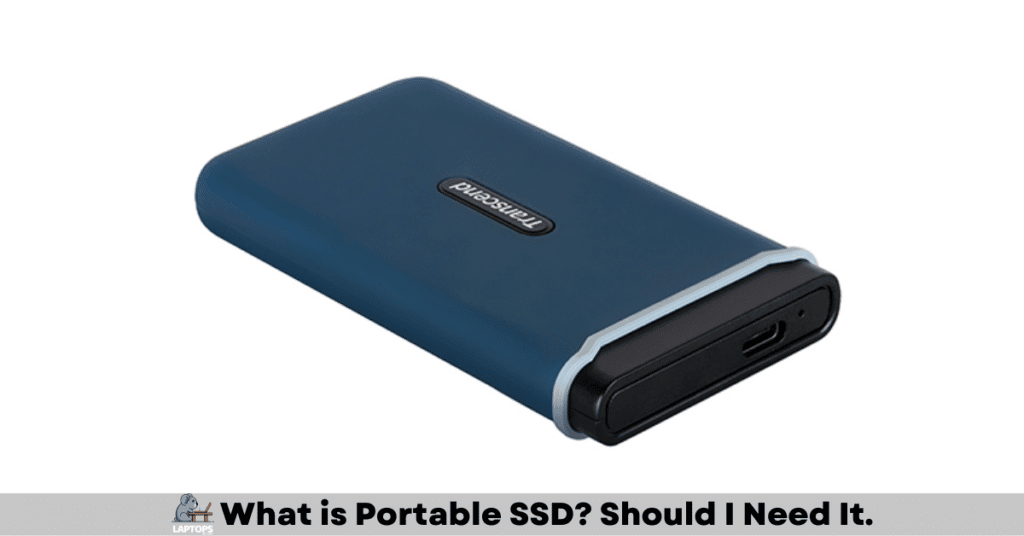
On the other hand, an internal SSD is installed inside a computer or other device and is typically used as the primary storage device. It is directly connected to the motherboard, allowing faster data transfer speeds.
In terms of performance, both types of SSDs offer fast access and data transfer speeds, but internal SSDs may have a slight edge due to their direct connection to the motherboard. However, portable SSDs offer the convenience of quickly transferring files between devices.
Pros and Cons of Internal SSD
When choosing a storage device, there are many factors to consider.
Internal SSDs offer several benefits, including faster data transfer speeds, more storage options, and improved performance.
However, they also have some drawbacks, such as cost and installation difficulty.
We will explore Major key factors to help you decide whether an internal SSD is the right choice for your needs.
Pros of internal SSD:
- Faster data transfer speeds: Because internal SSDs are directly connected to the motherboard, they have a quicker data transfer rate than external SSDs.
- More storage options: Internal SSDs are available in a wide range of storage capacities, from 128GB to over 4TB.
- Improved performance: Internal SSDs can improve a computer’s or device’s overall performance by reducing boot times and allowing faster access to applications and files.
Cons of internal SSD:
- Cost: Internal SSDs are typically more expensive than external SSDs.
- The difficulty of installation: Installing an internal SSD requires opening up the computer or device and replacing the existing hard drive. This can be challenging for users who are not comfortable with computer hardware.
- Limited portability: Unlike external SSDs, internal SSDs are not easily portable and cannot be easily transferred between devices.
Pros and Cons of External SSD
Below we will explore the pros and cons of external SSDs, including their portability, flexibility, and cost-effectiveness, to help you decide if an external SSD is the right choice.
Pros of external SSD:
- Portability: External SSDs are small and easily portable, allowing users to transfer files between devices quickly.
- Flexibility: External SSDs can be used with any device with a compatible USB or other external connection.
- Convenience: External SSDs can provide additional storage for users who need more space for their files without requiring them to open up their computer or device.
- Easy to use: External SSDs are plug-and-play devices, making them easy to set up and use without needing special software or drivers.
- Cost-effective: External SSDs are typically more affordable than internal SSDs, which makes them a good option for users who need additional storage on a budget.
Cons of External SSD:
- Slower data transfer speeds: Because external SSDs rely on a USB or other external connection, they have a slower data transfer rate than internal SSDs.
- Limited storage options: External SSDs are typically available in smaller storage capacities than internal SSDs.
- Dependency on external connection: External SSDs are only as fast as the external connection they are using, which can be limiting for users who need high-speed storage.
- Potential for data loss: External SSDs are more susceptible to damage and data loss because they are portable and can be easily misplaced or damaged.
- Compatibility issues: Not all devices are compatible with external SSDs, which can limit their use for some users.
Why Should We Need Internal SSD?
There are several reasons why you might need an internal SSD:
Faster data transfer speeds: Internal SSDs have a quicker data transfer rate than external SSDs, which can improve a computer’s or device’s overall performance.
More storage options: Internal SSDs are available in a broader range of storage capacities, allowing users to choose the right size for their needs.
Improved performance: Internal SSDs can reduce boot times and improve the performance of applications and games, making them a good choice for users who need high-speed storage.
Reliability: Internal SSDs are more durable and reliable than traditional hard drives, which makes them less likely to fail and lose important data.
Cost savings: In the long run, internal SSDs can save users money by reducing the need for frequent data backups and replacing failed hard drives.
Why Should We Need Internal SSD?
The following reason why should you need internal ssd are mentioned below:
Convenience: External SSDs are portable and can be easily connected to different devices, making them a good choice for users who need to transfer files between devices.
Cost: External SSDs are typically more affordable than internal SSDs, which makes them a good option for users on a budget.
Compatibility: External SSDs can be used with a wider range of devices, including computers, laptops, and game consoles.
Easy installation: Unlike internal SSDs, external SSDs do not require any complex installation process and can be easily connected to a device through a USB or other external connection.
Extra storage: External SSDs can provide additional storage space for users who need extra space for their files and applications.
FAQs (Internal SSD Vs External SSD 2023)
Do SSD Fit All Laptops?
Not all laptops are compatible with SSDs. To use an SSD in a laptop, the laptop must have an available drive bay or slot for the SSD.
Some laptops may also require a specific type of SSD, such as an mSATA or M.2 SSD, which may not be compatible with all SSDs.
It is essential to check the specifications of your laptop and the SSD you are considering purchasing to ensure compatibility.
If your laptop does not have an available drive bay or slot for an SSD, you may need to purchase a different laptop or upgrade to a newer model that is compatible with SSDs.
How To Know Which SSD Is Compatible With My Laptop?
To determine which SSD is compatible with your laptop, you will need to check the specifications of both the laptop and the SSD.
First, check your laptop's user manual or technical specifications to determine the type of SSD it is compatible with. This information may be listed under "Supported Storage Devices" or "Drive Bay/Slot Information".
Once you know the type of SSD compatible with your laptop, you can look for an SSD that matches those specifications. For example, if your laptop is compatible with a 2.5-inch SATA SSD, you will need to purchase an SSD that is the same size and uses the SATA interface.
It is important to note that not all SSDs of the same size and interface will be compatible with your laptop. Some laptops may require specific SSD models or firmware versions, so it is always best to double-check the compatibility before purchasing an SSD.
Why Is My External SSD So Slow?
There are several reasons why your external SSD may be slow:
The speed of the external connection: External SSDs rely on a USB or other external connection to transfer data, and that connection's speed can impact the SSD's overall speed. If you are using an older or slower USB connection, it may limit the speed of the external SSD.
The number of files on the SSD: As the number of files on an external SSD increases, the speed of the SSD may decrease. This is because the SSD has to work harder to access and transfer large amounts of data.
The type of files being transferred: Some files, such as large video or audio files, can take longer to transfer than smaller files. This can impact the overall speed of the external SSD.
The age and condition of the SSD: Over time, the performance of an external SSD may decrease due to wear and tear. This can cause the SSD to become slower and less efficient.
Last Words (Internal Vs External SSD 2023)
Choosing between an internal and external SSD ultimately depends on your specific needs and preferences.
Internal SSDs offer faster data transfer speeds and more storage options, but they require installation and are not easily portable.
They are also typically more expensive than external SSDs.
External SSDs, on the other hand, are more portable and convenient, but they have slower data transfer speeds and are limited by the speed of the external connection.
They are also more susceptible to data loss due to their portability.
Overall, internal SSDs are the best choice for users who need high-speed storage and don’t mind the added cost and installation process.
External SSDs are a good option for users who need additional storage on the go and are willing to sacrifice some speed for convenience.

